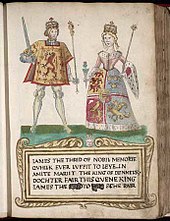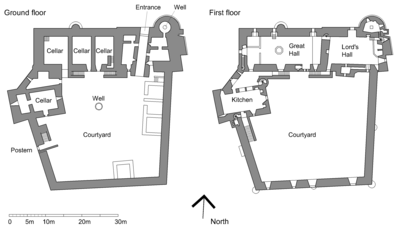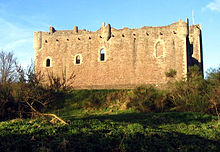Doune Castle
| Doune Castle | |
|---|---|
| Doune, Stirling, Scotland UK grid reference NN727010 | |
Aerial view of Doune Castle and the Castle keeper's cottage | |
King of Scotland (until late 16th century) Earl of Moray | |
| Open to the public | Yes |
| Condition | Ruined |
| Site history | |
| Built | c. 1400 |
| Built by | Robert Stewart, Duke of Albany |
| Materials | Stone (coursed rubble with dressed quoins) |
Doune Castle is a medieval stronghold near the village of
Recent research has shown that Doune Castle was originally built in the thirteenth century, then probably damaged in the
Due to the status of its builder, Doune reflected current ideas of what a royal castle building should be.[3] It was planned as a courtyard with ranges of buildings on each side, although only the northern and north-western buildings were completed.[4] These comprise a large tower house over the entrance, containing the rooms of the Lord and his family, and a separate tower containing the kitchen and guest rooms. The two are linked by the great hall. The stonework is almost all from the late 14th century, with only minor repairs carried out in the 1580s. The restoration of the 1880s replaced the timber roofs and internal floors, as well as interior fittings.
History

The site at the confluence of the Ardoch Burn and the River Teith had been fortified by the
Regent Albany

In 1361, Robert Stewart (c. 1340–1420), son of King Robert II (reigned 1371–1390), and brother of King Robert III (reigned 1390–1406), was created Earl of Menteith, and was granted the lands on which Doune Castle now stands. Building may have started any time after this, and the castle was at least partially complete in 1381, when a charter was sealed here.[3] Robert was appointed Regent in 1388 for his elderly father, and continued to hold effective power during the reign of his infirm brother. He was created Duke of Albany in 1398. In 1406, Robert III's successor, James I, was captured by the English, and Albany became Regent once more. After this time, the number of charters issued at Doune suggest that the castle became a favoured residence.[3]
Royal retreat

Albany died in 1420, and Doune, the dukedom of Albany, and the Regency all passed to his son Murdoch (1362–1425). The ransom for James I was finally paid to the English, and the King returned in 1424, taking immediate steps to gain control of his kingdom. Albany and two of his sons were imprisoned for treason, and then executed in May 1425. Doune Castle became a royal possession, under an appointed Captain, or Keeper, and served as a retreat and hunting lodge for the Scottish monarchs. It was also used as a dower house by Mary of Guelders (c. 1434–1463), Margaret of Denmark (1456–1486), and Margaret Tudor (1489–1541), the widowed consorts of James II, James III and James IV respectively.[2]
In March 1500, before his marriage to Margaret Tudor,
In 1528, Margaret Tudor, now Regent of Scotland for her infant son
Mary, Queen of Scots, (reigned 1542–1567) stayed at Doune on several occasions, occupying the suite of rooms above the kitchen.[8] Doune was held by forces loyal to Mary during the brief civil war which followed her forced abdication in 1567, but the garrison surrendered to the Regent, Matthew Stewart, 4th Earl of Lennox, in 1570, after a three-day blockade.[2] George Buchanan and Duncan Nairn, Deputy Sheriff of Stirling presided over the torture and interrogation of a messenger, John Moon, at Doune on 4 October 1570. Moon was carrying letters to Mary, Queen of Scots and Mary Seton.[9]
King
Prison and garrison


In 1607, the
Ruin and restoration

The castle deteriorated through the 18th century, and by 1800 Doune was a roofless ruin. It remained so until the 1880s, when George Stuart, 14th Earl of Moray (1816–1895) began repair works.
Description

Doune occupies a strategic site, close to the geographical centre of Scotland, and only five miles (eight kilometres) from Stirling Castle, the "crossroads of Scotland".[5] The site is naturally defended on three sides by steeply-sloping ground, and by the two rivers to east and west. The castle forms an irregular pentagon in plan, with buildings along the north and north-west sides enclosing a courtyard. It is entered from the north via a passage beneath a tower containing the principal rooms of the castle. From the courtyard, three sets of stone external stairs, which may be later additions,[13] lead up to the Lord's Hall in the tower, to the adjacent Great Hall, and to the kitchens in a second tower to the west.
The main approach, from the north, is defended by earthworks, comprising three ditches, with a
The Lord's tower
The principal tower, or

There is no direct communication between the ground floor and the Lord's Hall above, which occupies the whole first floor. This is accessed via an enclosed and gated stair from the courtyard. The hall is vaulted, and has an unusual double fireplace. The floor tiles, timber panelling, and minstrels' gallery are additions of the 1880s. It was originally thought that the connecting door to the Great Hall was also of this date, but is now accepted as being original.[5] Side rooms on the hall level include a chamber in the round tower, with a hatch above the well, and a small chamber within the south wall which overlooks both hall and courtyard. A machicolation below the hall's north window allows objects to be dropped onto attackers in the passage.[5]
Above the hall is a second hall, forming part of the Duchess' suite of rooms. An oratory in the south wall, overlooking the courtyard, contains a piscina and credence niche. The oratory gives access to mural passages leading to the walkway along the curtain wall. The timber ceiling of the Duchess' hall, and the timber floors and roof above, are of the 1880s. The upper parts of the stonework are among the repairs dating from 1580.[5]
Great Hall and kitchen tower

West of the Lord's tower is the Great Hall, 20 by 8 metres (66 by 26 ft), and 12 metres (39 ft) high to its timber roof,[2] again a 19th-century replacement.[5] The hall has no fireplace, and was presumably heated by a central fire, and ventilated by means of a louvre like the one in the modern roof. No details of the original roof construction are known, however, and the restoration is conjectural.[3] Large windows light the hall, and stairs lead down to the three cellars on ground level.
The hall is accessed from the courtyard via a stair up to a triangular lobby, which in turn links the hall and kitchens by means of two large serving hatches with
Courtyard and curtain wall
Projecting stones on the south wall of the kitchen block, known as tuskings, and four pointed-arched windows in the south curtain wall, suggest that further ranges of buildings were planned. The large, easternmost window, may have been intended for a chapel, and it is recorded that a chapel dedicated to the 8th-century monk
The curtain wall is 2 metres (6+1⁄2 ft) thick, and 12 metres (39 ft) high.[2] A walkway along the top of the wall is protected by parapets on both sides, and is carried over the pitched roofs of the hall and gatehouse by steep steps. Open, round turrets are located at each corner, with semicircular projections at the midpoint of each wall. A square turret with machicolations is located above the postern gate in the west wall.[5]

Interpretation of the layout
The Lord's tower is a secure, private set of rooms, probably intended for the sole use of the Lord and his family, and with its own lines of defence. The architectural historian
Grounds
This section needs expansion. You can help by adding to it. (March 2022) |
The castle is surrounded by woodland and parkland[16] along the banks of the River Teith and Ardoch Burn. In 2022 a new footbridge was constructed, spanning the Ardoch Burn. It was built using locally sourced larch timbers and provides a link from the immediate grounds of the castle to the site of an old mill.[17]
In fiction and drama

Doune Castle has featured in several literary works, including the 17th-century ballad, "
The castle was used as a location in
The castle depicted the fictional "Castle Leoch" in the TV adaptation of the Outlander series of novels.[22]
The castle was also used as a location in Outlaw King,[23] a 2018 historical action drama film about Robert the Bruce, the 14th-century Scottish King who launched a guerilla war against the larger English army. The film is largely set in the 3 years from 1304, when Bruce decides to rebel against the rule of Edward I over Scotland, thus becoming an "outlaw", up to the 1307 Battle of Loudoun Hill.[24]
Monty Python and the Holy Grail

The British comedy film Monty Python and the Holy Grail – a parody of the legends of King Arthur by the Monty Python team – was filmed on location in Scotland in 1974. The film's producers had gained permission from the National Trust for Scotland to film scenes at several of their Scottish castles, as well as the permission of Lord Moray to film at Doune Castle. However, the National Trust later withdrew their permission, leaving the producers with little time to find new locations. Instead, they decided to use different parts of Doune Castle to depict the various fictional castles in the film, relying on tight framing of shots to maintain the illusion.
Scenes featuring Doune Castle include:[25]
- At the start of the film, King Arthur (Graham Chapman) and Patsy (Terry Gilliam) approach the east wall of Doune Castle and argue with soldiers of the garrison.
- The song and dance routine "Knights of the Round Table" at "Camelot" was filmed in the Great Hall.
- The servery and kitchen appear as "Castle Anthrax", where Sir Galahad the Chaste (Michael Palin) is chased by seductive girls.
- The wedding disrupted by Sir Lancelot (John Cleese) was filmed in the courtyard and Great Hall.
- The Duchess' hall was used for filming the Swamp Castle scene where the prince (Terry Jones) is being held in a tower by ignorant guards (Graham Chapman and Eric Idle).
- The Trojan Rabbit scene was filmed in the entryway and into the courtyard.
The only other castles used for filming were Castle Stalker in Argyll, also privately owned, which appears as "Castle Aaaaarrrrrrggghhh" at the end of the film, and (briefly) Kidwelly Castle in Wales and Bodiam Castle in East Sussex. The DVD version of Monty Python and the Holy Grail includes a documentary, In Search of the Holy Grail Filming Locations, in which Michael Palin and Terry Jones revisit Doune and other sites used for filming. Doune Castle has become a place of pilgrimage for fans of Monty Python and the film. It used to hold an annual "Monty Python Day".[26]
References
- ^ a b c Oram, pp. 54–55
- ^ a b c d e f g h i j k l m n o Salter, pp. 82–84
- ^ a b c d e f g Fawcett, pp. 7–11
- ^ Tabraham, pp. 144–45
- ^ a b c d e f g h i j k l m n Gifford and Walker, pp. 378–82
- ^ Fawcett, p. 3
- ^ Register of the Privy Seal of Scotland, vol. 1 (Edinburgh 1908), pp. 69-70 no. 495.
- ^ a b Coventry, pp. 253–54
- ^ Calendar State Papers Scotland, vol. 3 (Edinburgh, 1903), pp. 384–85: A Diurnal of Remarkable Occurrents in Scotland (Bannatyne Club, 1833), pp. 185–86
- ^ Pringle, p. 8: Fraser, William, The Red Book of Menteith, vol. 2 (1880), 419–21, no. 125.
- ^ "John Witherspoon". The History of the Presbyterian Church. Archived from the original on 20 February 2008. Retrieved 30 December 2007.
- ^ Historic Environment Scotland. "Doune Castle (SM12765)". Retrieved 19 February 2019.
- ^ a b c Historic Environment Scotland. "Doune Castle (24738)". Canmore. Retrieved 29 October 2021.
- ^ MacGibbon and Ross, pp. 418–29
- ^ Simpson, pp. 73–83
- ^ "Doune Castle: Access". Historic Environment Scotland. Retrieved 7 March 2022.
- ^ "New Bridge connects Doune's heritage assets with the natural environment". Historic Environment Scotland. 4 March 2022. Archived from the original on 5 March 2022. Retrieved 7 March 2022.
- ^ "The Bonny Earl o' Moray". Retrieved 14 October 2008.
- ^ Scott, Walter (1814). "Chapter IX: A Nocturnal Adventure". Waverley. Retrieved 14 October 2008.
- ^ "Visit Scotland: Stage and Screen". Retrieved 10 January 2009.
- ^ "Medieval keep becomes film set". BBC News. 23 October 2009. Retrieved 25 October 2009.
- ^ Visit Scotland - Outlander Filming Locations
- ^ Outlaw King - Netflix
- ^ Behind the scenes - Historic Scotland
- ^ "Monty Python and the Holy Grail – Doune Castle". Scotland: the Movie Location Guide. Archived from the original on 11 December 2014. Retrieved 24 October 2008.
- ^ "Python fans in castle pilgrimage". BBC News. 4 September 2005. Retrieved 14 October 2008.
Bibliography
- Fawcett, Richard (1994). Scottish Architecture from the accession of the Stewarts to the Reformation, 1371–1560. Architectural History of Scotland. Edinburgh University Press. ISBN 978-0-7486-0465-4.
- Fraser, William (1880). The Red Book of Menteith. Edinburgh.
{{cite book}}: CS1 maint: location missing publisher (link) - Gifford, John; Walker, Frank Arneil (2002). Stirling and Central Scotland. Buildings of Scotland. Yale University Press. ISBN 0-300-09594-5.
- ISBN 0-901824-18-6.
- Oram, Richard (2011). "The Great House in Late Medieval Scotland: Courtyards and Towers c. 1300 – c. 1400"". In Airs, M.; Barnwell, P.S. (eds.). The Medieval Great House. Rewley House Studies in the Historic Environment. Shaun Tyas. pp. 43–60. ISBN 978-1-907730-07-8.
- Pringle, R. Denys (1987). Doune Castle. HMSO.
- Salter, Mike (1994). The Castles of the Heartland of Scotland. Folly Publications. ISBN 1-871731-18-6.
- S2CID 257300173.
- Tabraham, Chris (1997). Scotland's Castles. B.T. Batsford/Historic Scotland. ISBN 0-7134-8147-1.
External links
- Doune Castle – site information from Historic Environment Scotland
- Engraving of Doune Castle by James Fittler in the digitised copy of Scotia Depicta, or the antiquities, castles, public buildings, noblemen and gentlemen's seats, cities, towns and picturesque scenery of Scotland (1804) at National Library of Scotland

